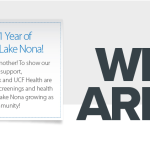You’ve probably driven by the beautiful $53 million, 106,000-square-foot University of Florida Research and Academic Center at Lake Nona. The center opened in November 2012 to offer research on new therapies and cures, more clinical research opportunities, and enhanced access to pharmacy education. But what exactly happens inside? This three-part series will explore the departments housed within the UF Research and Academic Center.
Part 1: University of Florida Institute for Therapeutic Innovation
Every day, a small group of scientists begin their work at the University of Florida Institute for Therapeutic Innovation (ITI) taking on some of the most well-known (and unknown) diseases affecting humanity today. The institute, part of the Department of Medicine at UF, develops optimized chemotherapy for medically important infectious diseases. In contrast to other labs, ITI does not focus upon a specific pathogen but applies the same therapeutic principles to many different pathogens. The team develops unique and innovative model systems that will kill pathogens and prevent them from becoming resistant to drugs. The ITI joined the University of Florida four years ago.
Its four award-wining principal investigators, Dr. Arnold Louie, Dr. Henry Heine, Dr. Ashley Brown, and Dr. George Drusano, each oversee a team of technicians. The scientists study mostly hospital-acquired infections such as pseudomonas and klebsiella. They also study more traditional pathogens, including mycobacterium tuberculosis; unusual pathogens that afflict our war fighters; and numerous viruses, including HIV, pandemic influenza, hepatitis C, dengue virus and Chikungunya virus.
Research on these pathogens is supported through grants financed by tax dollars. The institute currently has three RO1s or investigator-initiated research project grants from the National Institutes of Health (NIH). Within that, the grants come specifically from the National Institutes for Allergy and Infectious Diseases (NIAID) as well as from the Biomedical Advanced Research Development Authority (BARDA) and Defense Threat Reduction Agency (DTRA).
“We use a number of different model systems to look at new drugs and even old drugs,” says Dr. Drusano, Institute Director. The researchers apply relatively large mathematical models to the information they have gathered. The findings give the scientists better ways to cure patients. “We use the findings to identify how likely it is that a specific dose and schedule of a drug, or drugs in combination, will cure a patient,” explains Dr. Drusano.
In January, Dr. Drusano represented the lab at the National Institution for Allergies and Infectious Diseases (NIAID) US-Nordic-European Symposium resistance meeting that occurred in Stockholm, Sweden. He was one of only seven representatives from academia who were invited to the event.
The Institute is judged by its output of being able to attract grant money, particularly peer-reviewed grant money from the federal government. The team also is judged by the number of papers it publishes. “As a group, we get about 3 to 4 papers per year per investigator, so we end up publishing 9 to 12 papers,” Dr. Drusano says. Though it is getting increasingly more difficult to acquire grants for labs, Dr. Drusano and his colleagues have managed to keep the ITI fully funded. “It’s a never-ending process because your grants always end,” he says. “We just keep putting in more and more grants. You get about 1 out of 25.”
Once a grant is submitted, it takes about three to four months until the selection committee reviews it. After that, it’s another month or two before the scores are finalized. From there, the review committee sends back critiques. “I do three things here all year long. It’s like being a hamster on a wheel. One is writing grants. Two is writing the papers. If you get the grants and don’t write papers, they won’t give you any more grants. Third is doing the mathematical analysis that supports the writing of the papers. We all do that,” Dr. Drusano explains.
Currently, the lab is studying tuberculosis, specifically the multiple drug resistant (MDR) and extremely drug resistant (XDR) tuberculosis types that have very high mortality rates. The team will be discussing their findings in their next proposal. “We’ve identified a mathematical methodology to identify drug combinations that will kill MDR and XDR tuberculosis,” Dr. Drusano says. “We’ve been working with a lot of different drug companies. We have all their newest drugs that we can play with to be able to have a reasonably good chance of actually finding something that’s going to make a difference in the lives of people.”
Tuberculosis (TB) is a top infectious disease killer worldwide, killing about 1.5 million people per year, according to the World Health Organization. It can be passed from person to person by droplets and inhalation. “In this country, we have it under a little bit better control. We have a substantial number of MDR TB and XDR TB, but nothing like the former Soviet Union. They’re awash in it. We’re fairly lucky,” he continues.
The team just earned its most recent RO1s several months ago that will cover the work of the Institute for another five years or so.
“UF has been exceptionally good to us. I can honestly say the top leadership at UF in the College of Medicine, but also higher up – Dr. Thomas A. Pearson, EVP for Research and Education at the UF Health Sciences Center, and Dr. David S. Guzick, UF senior vice president for health affairs and president of UF Health – these people are really folks of vision. It’s an impressive group,” Dr. Drusano says.
“The man who brought us here, Dr. Steve Sugrue, the Senior Associate Dean for Research Affairs, has been absolutely, spectacularly good. He’s really helped foster a lot of the accomplishments that we’ve had since we’ve been here. This is honestly the one time in my entire career when I haven’t been known to moan, groan, and complain,” laughs Dr. Drusano.




